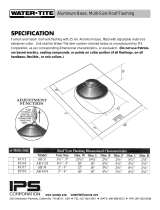
CLEARANCES AND APPLICATIONS
Simpson Dura-Vent's PelletVent Pro is listed
by Underwriters Laboratories as vent for listed
oil-, pellet-, and corn-burning appliances.
PelletVent Pro is also listed as a masonry
reliner, in which case the minimum clearance is
0" from vent to masonry, and 0" clearance from
the masonry to nearby combustibles. Never ll
any required clearance space with insulation
or any other materials. Combustible materials
include (but are not limited to) lumber, plywood,
sheetrock, plaster and lath, furniture, curtains,
electrical wiring, and building insulation of any
kind.
In the United States, the minimum clearance
to combustibles from PelletVent Pro is 1" for
oil-burning, pellet-burning, and corn-burning
applications.
In Canada, the minimum clearance to
combustibles from PelletVent Pro is 1" for oil-
burning applications, and 3" for pellet-burning
and corn-burning applications.
VENT LISTING
PelletVent Pro is listed by Underwriters
Laboratories (listing numbers MH8381 &
MH14420) to the American standard UL 641
Type L Low Temperature Venting Systems, and
is also listed to the Canadian standards ULC
S609 Standard for Low Temperature Vents
Type L and ULC/ORD-C441 Standard for Pellet
Vents.
3
INSTALLATION NOTES
Proper planning for your PelletVent Pro
installation will result in greater safety,
efciency, and convenience, saving both time
and money. Use only authorized Simpson
Dura-Vent PelletVent Pro listed parts. Do not
install damaged parts.
1. WARNING: When passing through ceilings
and walls, make sure all combustible materials
and building insulation products are a minimum
of 1" from the vent pipe (minimum of 3" in
Canada when used on pellet- or corn-burning
appliances).
2.
When exiting through walls, make sure NFPA
rules are followed for distance from windows
and openings. These rules are shown on page
7.
3. Do not mix and match with other products or
improvised solutions.
4. Practice good workmanship. Sloppy
work could jeopardize your PelletVent Pro
installation.
5. Never use a vent with an inside diameter that
is smaller than the appliance ue outlet.
6. Multistory: Where PelletVent Pro passes
through the ceiling, use Simpson Dura-Vent
Firestop/Support assembly.
7. PelletVent Pro placement: When deciding
the location of your stove and vent, try to
minimize the alteration and reframing of
structural components of the building.
8. Sections of pipe are connected to each
other by pushing them rmly together and
twisting. Screws are not required. If however,
screws are desired, use 1/4"-long sheet metal
screws. Under no circumstances, penetrate
the inner liner with screws.
9. PelletVent Pro does not need nor require
RTV Sealant to be used at joints, but it may
be used if desired. Check with the Appliance
Manufacturer for any additional requirements.



















